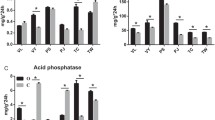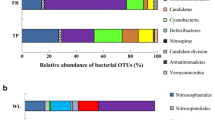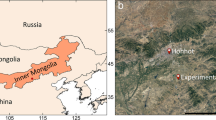Abstract
The application of organic mulches as a soil cover is effective in improving the quality of soil. However, very little information is available on the effect of mulches on the soil microbial community. In this study, we investigated the effect of various organic mulches on soil dehydrogenase activity (DHA) and microbial community structures in the top 1 cm and 5 cm below the soil surface 1 year after application of the mulches. DHA was stimulated at both depths in plots mulched with grass clippings (GC), but was not significantly different from the control for the other mulch treatments. Fatty acid methyl ester (FAME) analysis and denaturing gradient gel electrophoresis (DGGE) of polymerase chain reaction-amplified 16S rDNA fragments were used to assess changes in the soil microbial community structure. Cluster analysis and principle component analysis of FAME profiles showed that only soil mulched with pine chips distinctively clustered from the other treatments. At the soil surface, bacterial DGGE profiles revealed that distinct shifts in several bacterial populations occurred in soils mulched with GC and eucalyptus yardwaste (EY), while DGGE profiles from soil at the 5 cm depth revealed no distinct changes. Changes in bacterial diversity at the soil surface under different mulches were calculated based on the number of bands in the DGGE profile using the Shannon-Weaver index of diversity ( H). Compared to the control ( H =0.9), the GC- and EY-treated soils showed slightly increased bacterial diversity, with an H of 1.1 and 1.0, respectively. These results indicate that the long-term effect of organic mulches on the soil microbial activity and community structure is highly dependent upon the type of mulch and is mostly exerted in the top few centimeters of the soil profile.





Similar content being viewed by others
References
Abawi GS, Widmer TL (2000) Impact of soil health management practices on soilborne pathogens, nematode and root diseases of vegetable crops. Appl Soil Ecol 15:37–47
Akhtar M, Malik A (2000) Roles of organic soil amendments and soil organisms in the biological control of plant-parasitic nematodes: a review. Bioresource Technol 74:35–47
Albiach R, Canet R, Pomares F, Ingelmo F (2000) Microbial biomass content and enzymatic activities after the application of organic amendments to a horticultural soil. Bioresource Technol 75:43–48
Bandick AK, Dick RP (1999) Field management effects on soil enzyme activities. Soil Biol Biochem 31:1471–1479
Bending GD, Putland C, Rayns F (2000) Changes in microbial community metabolism and labile organic matter fractions as early indicators of the impact of management on soil biological quality. Biol Fertil Soils 31:78–84
Bonmati M, Pujola H, Sana J, Soliva J, Felipo MT, Garau M, Ceccanti B, Nannipieri P (1985) Chemical properties, populations of nitrite oxidizers, urease and phosphate activities in sewage sludge-amended soil. Plant Soil 84:79–91
Bossio DA, Scow KM, Gunapala N, Graham KJ (1998) Determinants of soil microbial communities: effect of agricultural management, season and soil type on phospholipid fatty acid profiles. Microbial Ecol 36:1–12
Brosius J, Dull TL, Sleeter DD, Noller HF (1981) Gene organization and primary structure of a ribosomal RNA operon from Escherichia coli. J Mol Biol 148:107–127
Casale WL, Minassian V, Menge JA, Lovatt CJ, Pond E, Johnson E, Guillemet F (1995) Urban and agricultural wastes for use as mulches on avocado and citrus for delivery of microbial biocontrol agents. J Hortic Sci 70:315–332
Casida LE, Klein DA Jr, Santoro T (1964) Soil dehydrogenase activity. Soil Sci 98:371–376
Cavigelli MA, Roberson GP, Klug MJ (1995) Fatty acid methyl ester (FAME) profiles as measures of soil microbial community structure. Plant Soil 170:99–113
Chander K, Brookes PS (1991) Is the dehydrogenase assay invalid as a method to estimate microbial activity in Cu-contaminated and non-contaminated soils? Soil Biol Biochem 23:901–915
Cillia V, Lafay B, Christen R (1996) Sequence heterogeneties among 16S ribosomal RNA sequences, and their effect on phylogenetic analyses at the species level. Mol Biol Evol 13:451–461
Dick RP, Breakwell DP, Turco RF (1996) Soil enzyme activity and biodiversity measurements as integrative microbiological indicators. In: Doran JW, Jones AJ (eds) Methods for assessing soil quality. SSSA special publication no. 49. SSSA, Madison, Wis., pp 247–271
Eichner CA, Erb RW, Timmis KN, Wagner-Dobler I (1999) Thermal gradient gel-electrophoresis analysis of bioprotection from pollutant shocks in the activated sludge microbial community. Appl Environ Microbiol 65:102–109
Frankenberger WT Jr, Dick WA (1983) Relationships between enzyme activities and microbial growth and activity indices in soil. Soil Sci Soc Am J 47:945–951
Gan J, Yates SR, Papiernik S, Crowley DE (1998) Application of organic amendments to reduce volatile pesticide emissions from soil. Environ Sci Technol 32:3094–3098
Haack SK, Garchow H, Odelson DA, Forney LJ, Klug MJ (1994) Accuracy, reproducibility, and interpretation of fatty acid methyl ester profiles of model bacterial communities. Appl Environ Microbiol 60:2483–2483
Hastings RC, Ceccherini MT, Miclaus N, Saunders JR, Bazzicalupo M, McCarthy AJ (1997) Direct molecular biological analysis of ammonia-oxidizing bacteria populations in cultivated soil plots treated with swine manure. FEMS Microbiol Ecol 23:45–54
Hill GT, Mitkowski NA, Aldrich-Wolfe L, Emele LR, Jurkonie DD, Ficke A, Malodonado-Ramirez S, Lynch ST, Nelson EB (2000) Methods for assessing the composition and diversity of soil microbial communities. Appl Soil Ecol 15:25–36
Ibekwe A, Kennedy A (1999) Fatty acid methyl ester (FAME) profiles as a tool to investigate community structure of two agricultural soils. Plant Soil 206:151–161
Ibekwe A, Papiernik SK, Gan J, Yates SR, Yang C-H, Crowley DE (2001) Impact of fumigants on soil microbial communities. Appl Environ Microbiol 67:3245–3257
Jensen S, Øvreås L, Daae FL, Torsvik V (1998) Diversity in methane enrichments from agricultural soil revealed by DGGE separation of PCR amplified 16S rDNA fragments. FEMS Microbiol Ecol 26:17–26
Konopka A, Turco RF (1991) Biodegradation of organic compounds in vadose zone and aquifer sediments. Appl Environ Microbiol 57:2260–2268
Kowalchuk GA, Stephen JR, De Boer W, Prosser JI, Embley TM, Woldendrop JW (1997) Analysis of ammonia-oxidizing bacteria of the beta subdivision of the class Proteobacteria in coastal sand dunes by denaturing gradient gel electrophoresis and sequencing of PCR-amplified 16S ribosomal DNA fragments. Appl Environ Microbiol 63:1489–1497
Kowalchuk GA, Bodelier PLE, Heilig GHJ, Stephen JR, Laanbroek HJ (1998) Community analysis of ammonia-oxidizing bacteria, in relation to oxygen-availability in soils and root-oxygenated sediments, using PCR, DGGE and oligonucleotide probe hybridization. FEMS Microbiol Ecol 27:339–350
Kowalchuk GA, Naoumenko ZA, Derikx PJL, Felske A, Stephen JR, Arkhipchenko IA (1999) Molecular analysis of ammonia-oxidizing bacteria of the beta subdivision of the class Proteobacteria in compost and composted materials. Appl Environ Microbiol 65:396–403
Ladd JN (1978) Origin and range of enzymes in soil. In: Burns RG (ed) Soil enzymes. Dekker, New York, pp 51–96
Ladd JN, Paul EA (1973) Changes in enzymatic activity and distribution of acid-soluble, amino acid nitrogen in soil during nitrogen immobilization and mineralization. Soil Biol Biochem 5:825–840
Lawlor K, Knight BP, Barbosa-Jefferson VL, Lane PW, Lilley AK, Paton GI, McGrath SP, O'Flaherty SM, Hirsch PR (2000) Comparison of methods to investigate microbial populations in soils under different agricultural management. FEMS Microbiol Ecol 33:129–137
Marzadori G, Ciavatta C, Montecchio D, Gessa C (1996) Effects of lead pollution on different soil enzyme activities. Biol Fertil Soils 22:53–58
Mersi W von, Schinner F (1991) An improved and accurate method for determining the dehydrogenase activity of soils with iodonitrotetrazolium chloride. Biol Fertil Soils 11:216–220
Morgan JAW, Winstanley C (1997) Microbial biomarkers. In: Elsas JD van, Trevors JT, Wellington EMH (eds) Modern soil microbiology. Dekker, New York, pp 331–352
Muyzer G, de Waal EC, Uitterlinden AG (1993) Profiling of complex microbial populations by denaturing gradient gel electrophoresis analysis of polymerase chain reaction-amplified genes coding 16S rRNA. Appl Environ Microbiol 59:695–700
Nannipieri P, Muccini L, Ciardi C (1983) Microbial biomass and enzyme activities: production and persistence. Soil Biol Biochem 15:679–685
Nübel U, Engelen B, Felske A, Snaidr J, Wleshuber A, Amann R, Ludwig W, Backhaus H (1996) Sequence heterogeneities of genes encoding 16S RNAs in Paenibacillus polymyxa detected by temperature gradient gel electrophoresis. J Bacteriol 178:5636–5643
Øvreås L, Forney L, Daae FL, Torsvik V (1997) Distribution of bacterioplankton in meromictic Lake Saelevannet, as determined by denaturing gradient gel electrophoresis of PCR amplified gene fragments coding for 16S rRNA. Appl Environ Microbiol 63:3367–3373
Peascock AD, Mullen MD, Ringelberg DB, Tyler DD, Hedrick DB, Gale PM, White DC (2001) Soil microbial community response to dairy manure or ammonium nitrate applications. Soil Biol Biochem 33:1011–1019
Perucci P (1990) Effect of addition of municipal solid waste compost on microbial biomass and enzyme activities. Biol Fertil Soils 10:221–226
Perucci P, Scarponi L, Businelli M (1984) Enzyme activities in a clay-loam soil amended with various crop residues. Plant Soil 81:345–351
Pickup RW (1991) Development of molecular methods for the detection of specific bacteria in the environment. J Gen Microbiol 137:1009–1019
Prosser JI (1989) Autotrophic nitrification in bacteria. Adv Microb Physiol 30:125–181
Rainey FA, Ward-Rainey NL, Janssen PH, Hippe H, Stackebrandt E (1996) Clostridium paradoxum DSM 7308T contains multiple 16S rRNA genes with heterogeneous intervening sequences. Microbiology 142:2087–2095
Ratledge C, Wilkinson SG (1988) Microbial lipids, vol 1. Academic Press, New York
Rodale JI (1974) The complete book of composting. Rodale, Emmaus, Pa.
Sherlock Microbial Identification System (1999) Version 3.1. MIDI, Newark, Del.
Skujins J (1973) Dehydrogenase: an indicator of biological activities in arid soils. Bull Ecol Res Commun NFR 17:235–2451
Speir TW (1977) Studies on a climosequence of soils in tussock grasslands. 11. Urease, phosphatase and sulphatase activities of topsoils and their relationship with other soil properties including plant available sulfur. NZ J Sci 20:159–166
Speir TW, Ross DJ (1976) Studies on a climosequence of soils in tussock grasslands. 9. Influences of age of Chionochloa rigida leaves on enzyme activities. N Z J Sci 19:389–396
Stackebrandt E, Liesack W, Goebel BM (1993) Bacterial diversity in a soil sample from a subtropical Australian environment as determined by 16S rDNA analysis. FASEB J 7:232–237
Stephen JR, Kowalchuk GA, Burns MAV, McCaig AE, Phillips CJ, Embley TM, Prosser JI (1998) Analysis of β-subgroup ammonia oxidizer population in soils by DGGE analysis and hierarchical phylogenetic probing. Appl Environ Microbiol 64:2958–2965
Stevenson IL (1959) Dehydrogenase activity in soils. Can J Microbiol 5:229–235
Tunlid A, White DC (1992) Biochemical analysis of biomass, community structure, nutritional status, and metabolic activity of microbial communities in soils. In: Stotzky G, Bollag JM (eds) Soil Biochemistry. Dekker, New York, pp 229–262
Vallaeys T, Topp E, Muyzer G, Macheret V, Laguerre G, Rigaud A, Soulas G (1997) Evaluation of denaturing gradient gel electrophoresis in the detection of 16 s rDNA sequence variation in the rhizobia and methanotrophs. FEMS Microbial Ecol 24:279–285
Vestal JR, White DC (1989) Lipid analysis in microbial ecology. Bioscience 39:535–541
Zelles L, Bai QY, Beck T, Beese F (1992) Signature fatty acids in phospholipids and lipopolysaccharides as indicators of microbial biomass and community structure in agricultural soils. Soil Biol Biochem 24:317–323
Zelles L, Palojarvi A, Kandeler E, von Lutzow M, Winter K, Bai QY (1997) Changes in soil microbial properties and phospholipid fatty acid fractions after chloroform fumigation. Soil Biol Biochem 29:1325–1336
Author information
Authors and Affiliations
Corresponding author
Rights and permissions
About this article
Cite this article
Yang, YJ., Dungan, R.S., Ibekwe, A.M. et al. Effect of organic mulches on soil bacterial communities one year after application. Biol Fertil Soils 38, 273–281 (2003). https://doi.org/10.1007/s00374-003-0639-9
Received:
Accepted:
Published:
Issue Date:
DOI: https://doi.org/10.1007/s00374-003-0639-9




